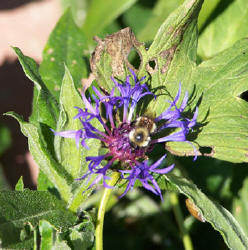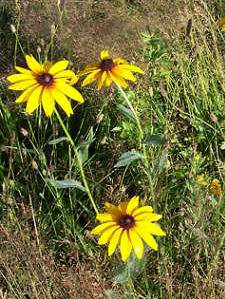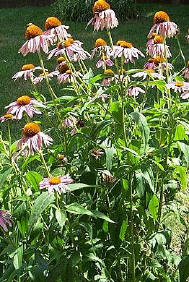Stephanie Kriess
Frederick County Master Gardener Program
It is difficult to know what to do about investing in new plant material this year. In spite of fears of drought, it has been raining some this spring and I believe you can buy new plants and have good success with them this season. However, you must
give careful attention to plant selection, placement and care. In fact with the increasing frequency of water shortages in this area over recent years, careful selection of drought tolerant plants should be the norm, rather than the exception.
There are many beautiful drought tolerant plants that are readily available in local nurseries and home/garden stores. They come in a wide range of colors and sizes. Some good perennials include:
|

Perennial Bachelors Button
Centaurea montana
|
Perennial Bachelors Button (Centaurea montana). This lovely rounded plant grows about 12 inches high and 12 inches wide. Its leaves are long and a silvery green. Flowers are blue and about 2 inches in diameter. With deadheading (removal of spent
flower heads before they go to seed) Centaurea will bloom from May through September. The one downfall of this plant is that it spreads by underground runners and may also reseeds itself throughout the garden. You can take care of this problem by pulling up unwanted
seedlings in the spring.
Daylily (Hemrocallis). We are all familiar with the daylily by now. There are more than 20,000 registered hybrids, in colors ranging from yellow, to red to deep purple. They range in height from 6 inches to over 30 inches. Most bloom only once per
summer, but every year more repeat or continuous bloomers are being developed. The most famous and earliest repeat bloomer is 'Stella d'Oro'. The foliage of daylilies stays attractive all summer, although the appearance of the plant does benefit from removal of spent flower
heads and browning leaves. Daylilies generally need to be divided every 4 or 5 years.
Candytuft (Iberis sermpervirens) is a great spring-blooming low-growing plant for the front of the border. The flowers last for about 10 weeks. Its evergreen foliage is dark green and the flowers are pure white. The plants have a woody base and
should be cut back severely every other year to insure that they do not get leggy.
|

Black-eyed Susan
Rudbeckia hirta

Purple Cone Flower
Echinacea purpurea |
Black Eyed Susan (Rudbeckia hirta) and Coneflower (Echinacea) are well-known summer blooming, daisy-like flowers of similar habit. They come in yellow, pink and white. Plants typically grow 3 to 4 feet high, although some dwarf varieties have been
developed. These are low maintenance plants, but deadheading is recommended to improve plant appearance and prevent reseeding.
I could go on-and-on describing drought tolerant perennials; however, space does not permit. The Maryland Cooperative Extension Service has a publication number HG25, "Xeriscaping and Conserving Water in the Landscape" that lists many more draught
tolerant perennials, as well as trees and shrubs.
Many of our popular annuals are also quite tolerant of dry conditions. Marigold, Zinnia, Geranium (Pelargonium), Spider Flower (Cleome), Cosmos, Portulaca, Nasturtium are just a few. Most herbs are also happy in low water conditions, as are
ornamental grasses.
Americans have had a great love affair with the Impatience plant for many years. This is one plant that has high water needs. If you do want to plant Impatience put them in shady areas where water will not evaporate from the soil quickly. Also be
sure to mulch the soil around the plants.
Even drought tolerant plants will not grow completely without water. Their needs are about 50 percent of the water needs of non-drought tolerant plants. What should you do to insure their survival? First of all, now is the time to buy and plant them!
We are getting some rain and weather conditions are somewhat cooler than they will be in June, July and August. Buying and planting them now, and hand watering them when rain is insufficient will give them the start they need to survive a hot, dry summer. Water your plants
infrequently as deeply as your soil drainage situation permits, rather than doing light, frequent waterings. Deep watering encourages deep root development, which will stand your plants in good stead when dry, hot summer conditions arrive.
Other things you can do to ensure your plants' survival include mulching your beds about 2 inches deep. This helps the soil retain moisture and also reduces the temperature of the soil surface.
When planning your garden, it is good idea to try to group your plants according to their water needs, as well as taking into consideration their sun/shade tolerance. By planting your water and typically shade loving plants away from the drought
tolerant ones, you will avoid over watering the latter in order to keep the former alive.
Keep container gardening to a minimum under hot and dry conditions. Containers will need watering once per day, if not more in mid-summer. If you do have containers, mulch them as you do your garden and keep them in a shady area on really hot days.
If water restrictions become severe, concentrate on keeping your trees and shrubs alive first, then your perennials. Let your annuals go if you must.